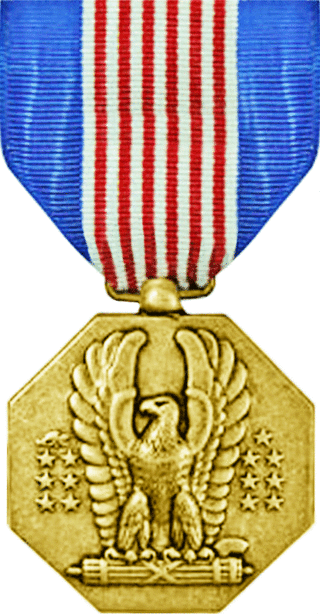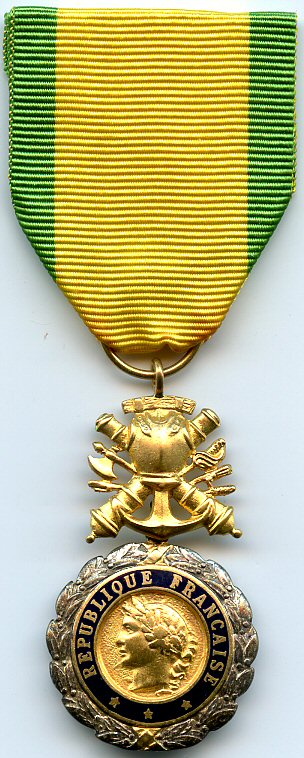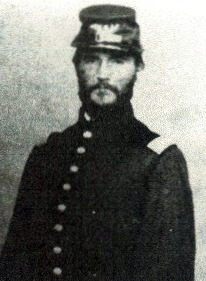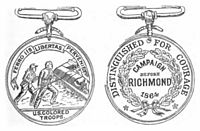
United States Colored Troops (USCT) were Union Army regiments during the American Civil War that primarily comprised African Americans, with soldiers from other ethnic groups also serving in USCT units. Established in response to a demand for more units from Union Army commanders, by the end of the war in 1865 USCT regiments, which numbered 175 in total, constituted about one-tenth of the manpower of the army. Approximately 20% of USCT soldiers were killed in action or died of disease and other causes, a rate about 35% higher than that of white Union troops. Numerous USCT soldiers fought with distinction, with 16 receiving the Medal of Honor. The USCT regiments were precursors to the Buffalo Soldier units which fought in the American Indian Wars.

The Soldier's Medal is an individual decoration of the United States Army. It was introduced as Section 11 of the Air Corps Act, passed by the Congress of the United States on July 2, 1926. The Soldier's Medal is equivalent to the Navy and Marine Corps Medal, the Air and Space Forces' Airman's Medal, and the Coast Guard Medal. Prior to the creation of the Airman's Medal in 1960, airmen were awarded the Soldier's Medal.

The Médaille militaire is a military decoration of the French Republic for other ranks for meritorious service and acts of bravery in action against an enemy force. It is the third highest award of the French Republic, after the Légion d'honneur, a civil and military order, and the ordre de la Libération, a Second World War-only order. The Médaille militaire is therefore the most senior entirely military active French decoration.
To be mentioned in dispatches describes a member of the armed forces whose name appears in an official report written by a superior officer and sent to the high command, in which their gallant or meritorious action in the face of the enemy is described.

The Military Medal (MM) was a military decoration awarded to personnel of the British Army and other arms of the armed forces, and to personnel of other Commonwealth countries, below commissioned rank, for bravery in battle on land. The award was established in 1916, with retrospective application to 1914, and was awarded to other ranks for "acts of gallantry and devotion to duty under fire". The award was discontinued in 1993, when it was replaced by the Military Cross, which was extended to all ranks, while other Commonwealth nations instituted their own award systems in the post war period.

The Battle of Chaffin's Farm and New Market Heights, also known as Laurel Hill and combats at Forts Harrison, Johnson, and Gilmer, was fought in Virginia on September 29–30, 1864, as part of the siege of Petersburg in the American Civil War.

The Nkwe ya Selefera - Silver Leopard, post-nominal letters NS, was instituted by the President of the Republic of South Africa on 16 April 2003 and came into effect on 27 April 2003. It is South Africa's second highest military decoration for bravery.

The Nkwe ya Boronse - Bronze Leopard, post-nominal letters NB, is a military decoration for bravery which was instituted in 2003. It is South Africa's third highest military decoration for bravery.

Dutch Gap Canal is located on the James River in Chesterfield County, Virginia just north of the lost 17th-century town of Henricus. The canal's construction was initiated by Union forces during the American Civil War to bypass a meander loop of the river around a peninsula known as Farrar's Island that was controlled by Confederate artillery. The canal was completed after the war and is now the main channel of the James River in this area. Today, the area south of the canal is the location of the Dutch Gap Conservation Area and Henricus Historical Park.

The African American Civil War Memorial Museum, in the U Street district of Washington, D.C., recognizes the contributions of the 209,145 members of the United States Colored Troops (USCT). The eponymous memorial, dedicated in July 1998 by the African American Civil War Memorial Freedom Foundation, commemorates the service of 209,145 African-American soldiers and about 7,000 white and 2,145 Hispanic soldiers, together with the approximate 20,000 unsegregated Navy sailors, who fought for the Union in the American Civil War, mostly among the 175 regiments of United States Colored Troops.

Powhatan Beaty was an African American soldier and actor. During the American Civil War, he served in the Union Army's 5th United States Colored Infantry Regiment throughout the Richmond–Petersburg Campaign. He received America's highest military decoration, the Medal of Honor, for taking command of his company at the Battle of Chaffin's Farm, after all officers had been killed or wounded.

James H. Bronson was an African American Union Army soldier during the American Civil War and a recipient of America's highest military decoration, the Medal of Honor.

Charles Veale or Veal was an African American Union Army soldier during the American Civil War and a recipient of America's highest military decoration—the Medal of Honor—for his actions at the Battle of Chaffin's Farm.

The 5th United States Colored Infantry Regiment was an African American regiment of the Union Army during the American Civil War. A part of the United States Colored Troops, the regiment saw action in Virginia as part of the Richmond–Petersburg Campaign and in North Carolina, where it participated in the attacks on Fort Fisher and Wilmington and the Carolinas Campaign.
The 6th United States Colored Infantry Regiment was an African American unit of the Union Army during the American Civil War. A part of the United States Colored Troops, the regiment saw action in Virginia as part of the Richmond–Petersburg Campaign and in North Carolina, where it participated in the attacks on Fort Fisher and Wilmington and the Carolinas Campaign.

Nathan Huntley Edgerton was a Union Army officer who received the Medal of Honor for gallantry in the American Civil War.

A large contingent of African Americans served in the American Civil War. The 186,097 black men who joined the Union Army included 7,122 officers and 178,975 enlisted soldiers. Approximately 20,000 black sailors served in the Union Navy and formed a large percentage of many ships' crews. Later in the war, many regiments were recruited and organized as the United States Colored Troops, which reinforced the Northern forces substantially during the conflict's last two years. Both Northern Free Negro and Southern runaway slaves joined the fight. Throughout the course of the war, black soldiers served in forty major battles and hundreds of more minor skirmishes; sixteen African Americans received the Medal of Honor.

The Medal "For Courage" or Medal "For Valour" is a state decoration of the Russian Federation that was retained from the Soviet awards system following the dissolution of the USSR.

The Battle of Island Mound State Historic Site is located in a rural area of Bates County, Missouri, in the western part of the state. The site was established to preserve the area of the American Civil War battle that took place in October 28–29, 1862 between Union forces and Confederate guerrillas. The battle was significant as the first time African-American troops on the Union side engaged enemy white troops in the Civil War. A correspondent of The New York Times reported on the battle; the headline noted the "desperate bravery" of the African Americans in achieving Union victory.
The 36th United States Colored Infantry was an infantry regiment that served in the Union Army during the American Civil War. The regiment was composed of African American enlisted men commanded by white officers and was authorized by the Bureau of Colored Troops which was created by the United States War Department on May 22, 1863.


















